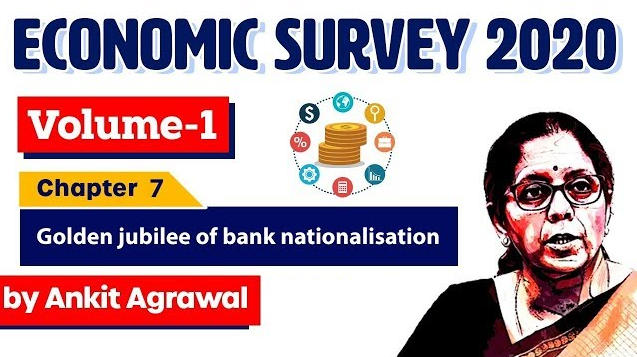Table of Contents

INTRODUCTION
- In 2019, India completed the 50th anniversary of the bank nationalization programme undertaken in
- As PSBs account for 70% of the market share in banking, an assessment of the state of India’s public sector banks (PSBs) is apposite.
- India’s banks are disproportionately small compared to the size of its economy.
- In 2019, when Indian economy is the 5th largest in the world, our highest ranked bank—State Bank of India— is ranked a lowly 55th in the world and is the only bank to be ranked in the Global top 100.




BANKING STRUCTURE: NATIONALIZATION TO TODAY
- SBI was founded as Bank of Calcutta in 1806, took the name Imperial Bank of India in 1921 and became state-owned in
- The remaining PSBs in India were formed through two waves of nationalizations, one in 1969 and the other in
- After the 1980 nationalization, PSBs had a 91% share.
- As of March 2019, PSBs had 80 lakh crore in deposits and made loans and advances of 58 lakh crore.
- They also hold about 20 lakh crore of the government debt, a large part of it driven by the requirements for a minimum “statutory liquidity” ratio.
- The decline in PSB market share has been largely absorbed by “new private banks” (NPBs), which were licensed in the early 1990s after a liberalization of licensing rules.
Key difference between PSBs & Private Banks-
- PSBs enjoy less strategic and operating freedom because of majority government ownership.
- Government exercises significant control over all aspects of PSB operations- from policies on recruitment and pay to investments and financing and bank governance.
- It results in an implicit promise of the bailout of bank liabilities.
- It also subjects PSB officers to scrutiny of their decisions by the CVC & CAG.
- With no real restrictions on what can be investigated and under what circumstances, officers of state-run banks are wary of taking risks in lending or in renegotiating bad debt.
BENEFITS OF NATIONALIZATION
- The allocations of banking resources to rural areas, agriculture, and priority sectors
- The number of rural bank branches increased 10-fold from about 1,443 in 1969 to 15,105 in 1980.
- Credit to rural areas increased from 115 crore to 3,000 crore.
- Deposits in rural areas increased from 306 crore to 5,939 crore.
- Credit to agriculture expanded 40-fold from 67 crore to 2,767 crore.
- RBI after nationalization also introduced PSL norms which led to this growth.
WEAKENING OF PUBLIC SECTOR BANKS
- In 2019 public sector banks reported gross and net NPAs of 4 lakh crore and 4.4 lakh crore respectively.
- This is amounting to about 80% of the NPAs of India’s banking system.
- The gross NPAs of PSBs amount to a significant 59% of their gross advances
- In 2019, PSBs suffered losses of 661 billion compared to profits of 421 billion of other scheduled commercial banks.
- Besides the NPAs, frauds are another source of concern in
- PSBs account for 9% of the 5,835 cases of fraud reported in 2017-2018.
- PERFORMANCE COMPARISON B/W PSB & NPB



HOW TO ENHANCE EFFICIENCY OF PSB THE WAY FORWARD
- The key drivers of India’s growth prospects are now-
- Highly favourable
- Modern digital infrastructure- the “JAM” trinity.
- Uniform indirect taxation system- GST


- Previously, The Narasimhan Committee (1991, 1997), Rajan Committee (2007), P J Nayak Committee (2014)
- Have provided several suggestions to enhance the efficiency of PSBs.
- The Survey, therefore, focuses on 2 ideas for enhancing the efficiency of PSBs that have hitherto not been explored.
Credit Analytics using-
- Artificial Intelligence & Machine Learning
- The data that can be employed for credit analytics is available in both structured and unstructured form.
- Data in a structured form include credit information and credit scores based on loan grants and repayments held in the credit registries or credit bureaus.
- The richer, though unstructured, micro-data is available in text, images, geo-tagged data, social network data, mobile apps, etc.
- Leveraging these data requires new data, analytics, and modelling skills.
- Banks need to invest in credit recovery
Benefits Of Credit Analytics
- A large proportion of NPAs of Indian banks, especially PSBs, could have been prevented if data and analytics were employed in corporate lending.

CONCLUSION
- A large economy needs an efficient banking sector to support its growth.
- Should India’s banks play a role proportionate to its economic size, India should have 6 banks in the top 100.
- The survey suggests use of FinTech (Financial Technology) across all banking functions to enhance efficiencies in PSBs.
Economic Survey | Free PDF






















 WhatsApp
WhatsApp